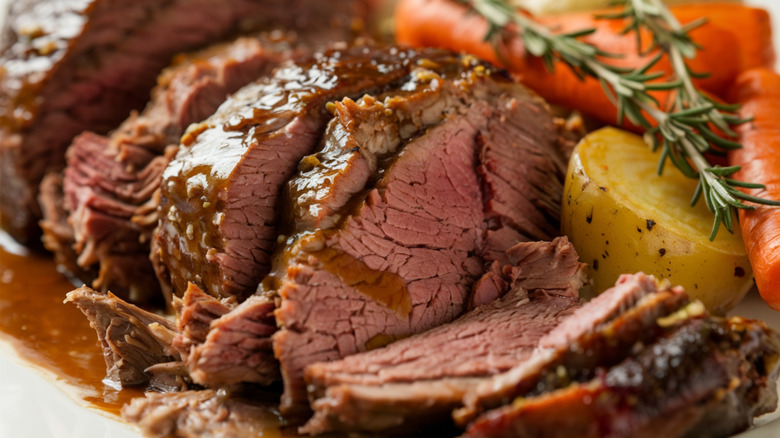Why Browning Pot Roast Meat Is Important, According To Ree Drummond
Ree Drummond's perfect pot roast is rich, tender, and beefy, but only because she avoids a mistake everyone makes with the recipe: failing to sear it first. While it may not be a critical step, the Pioneer Woman insists that it helps your protein develop its full potential, delivering a much better product for minimal effort.
Searing meat is a game-changer for slow cooker meals, not because it locks in juices (it doesn't) or tenderizes the muscle fibers, but because it brings out some amazing flavors. Searing the exterior of a roast triggers the Maillard reaction, a common chemical phenomenon responsible for flavorful steak crusts, beautifully browned chicken skin, and other hearty elements of properly cooked meat. When you slow-cook your protein, all that taste disperses into your liquid of choice, infusing your gravy with roasted, caramelized notes and creating a significantly better flavor profile. Overall, browning pot roast meat is important to achieving that hearty, down-home flavor you want, and it only takes a few minutes in a hot pan.
If you just drop a seasoned, raw roast into a crock pot, you'll still get a good result, but you won't ever achieve a great one. While the texture, aroma, and general taste might be similar, it's basically the difference between eating a boiled steak and one cooked in a pan. Finding ways to incorporate the caramelized flavor of properly browned ingredients is important if you want a great meal, and fortunately, it's easy to accomplish.
Other ways to get caramelized notes into your pot roast
Most pot roast recipes call for slow-cooking the meat with a medley of vegetables, and Ree Drummond's is no different. However, she doesn't stop the caramelization at just the meat, electing to also brown her onions and carrots before adding them to the pot.
For flawlessly cooked onions, you don't need to fully caramelize them beforehand. After searing your pot roast, cut the onions into large chunks and toss them in the same pan to absorb all that fat and juice. This infuses them with beefy flavor while removing some of their harsh bite, making them a milder, smoother ingredient for your meal overall. Plus, this helps deglaze the pan a bit, picking up any of that burnt goodness (called fond) stuck to the surface that can help elevate your roast even further.
Root vegetables like carrots are a bit trickier. You don't want to render them into mush, but you also want to caramelize their sugars a bit. Just like your pot roast, focus on browning their outsides over higher temperatures rather than attempting to cook them all the way to their interiors. It may help to pat dry and salt their exteriors, removing any excess moisture that you'd otherwise need to evaporate away before the browning process kicks in. Provided they're in large enough chunks, you should be able to give them great flavor without compromising their textures.


